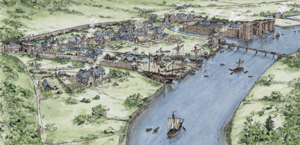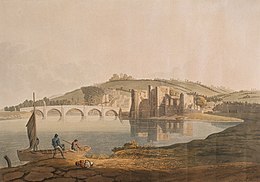Pil (placename)
Pîl is a Welsh placename element. The name is defined as the tidal reach of a waterway, suitable as a harbour, but is only common along the Bristol Channel and Severn Estuary. The highly localised distribution suggests it may have only been applicable to waterways within the tidal reach of the Severn sea.[1]

The name is today most commonly associated with the village of Pyle in Glamorgan, and the small village of Pill in Somerset.
Usage
In toponymy and hydronymy the word is often mistaken for another Welsh word "Pŵll" ("Pool"), however there is no proven link between the words and the both forms are often found within the same localities (for example, medieval Caerleon had a Pwll Mawr and a Pîl Mawr either side of the Roman port). Pîl may have developed a secondary meaning of 'refuge', as the name appears in some inland areas (such as Pilleth in Powys).
Although the name is associated with the coastline of Glamorgan and Gwent, it is found on both sides of the Severn, from Pembrokeshire in the west to Somerset and Gloucestershire in the East. In South West England, the word is rendered as Pill, and is interpreted by Robert Macfarlane as denoting "a tidal creek or stream...capable of holding small barges". Rick Turner noted the word as part of a common lexicon, shared across the Gwent, Somerset and Gloucestershire Levels.[2][3]
History

The predominance of "Pîl" in the area is an indication of their importance to the local maritime culture, especially along the river Usk where Pîls are found at the old Roman port in Caerleon and the later city of Newport. Newport developed around a number of Pîls, such as those at Pillgwenlly, said to have been the base of piracy by Gwynllyw (the future patron saint of Newport, it's Cathedral and pirates) and Arthur's Pîl (or Town Pîl), the site of the 2002 archaeological discovery of the Newport ship (now the Riverfront Arts Centre).[4][5][6]
Place names with the element
Bristol
- Stup Pill Rhine
Camarthenshire
- Pil Dafen, a tidal stream in the National Wetlands Centre at Llanelli
Glamorgan
Devon
Gloucestershire
- Berkeley Pill
- Brims Pill, Newnham
- Bullo Pill, Newnham
- Hill Pill
- Pilning
- The Pill, a Waterway running through the village of Pilning and the Pilning Wetlands
- Waldings Pill
Gwent
- Arthur's Pill or Town Pill, Newport (no longer extant)
- Crindau Pill
- Pillgwenlly, Newport
- Pillmawr
- Spytty Pill, Newport
- Goldcliff Pill
Monmouthshire
- Chapel Pill
- Collister Pill Reen
- Mathern Pill
- Mireland Pill Reen
- St. Pierre Pill
- Towyn Pill Reen
- West Pill Reen
Pembrokshire
- Castle Pill, near Milford Haven
- Cosheston Pill, Pembroke Dock
- Garon Pill, Lawrenny
- Goldborough Pill
- Hubberston Pill, the waterway from which Pill Priory is named.
- Jacob's Pill
- Llangwm Pill,
- Millin Pill
- Pill Priory
- Quoits Water Pill, Pembroke
- Sprinkle Pill
- Westfield Pill, Neyland.
- West Llanion Pill, Pembroke Dock
Somerset
- Chapel Pill
- Combwich Pill
- Huntspill
- Huntspill River
- Kilve Pill
- Kingston Pill
- Pill, Somerset
- Pill Bridge, Ilchester
- Pill River, Chapel Cleeve
- Pilton, Somerset
- Pims Pill Reach
- Pylle
- Stroud Pill
See also
- Celtic onomastics
- Celtic toponymy
- List of generic forms in place names in the United Kingdom and Ireland
- Toponymy in Great Britain
- Welsh place names in other countries
- Welsh toponymy
References
- Owen, William (1803). A Dictionary of the Welsh Language (Vol II ed.). London.
- Macfarlane, Robert (5 March 2015). Landmarks. London: Penguin, UK. ISBN 0241967864.
- Turner, Rick. "Unique Levels Lingo". Living Levels.
- Jones,Stone, Evan T, Richard, ed. (2018). The World of the Newport Medieval Ship: Trade, Politics and Shipping in the mid-fifteenth century. University of Wales Press. ISBN 1786831457.
- Robin Gwyndaf, Welsh Folk Tales (National Museum of Wales, 1989), p. 96
- Trett, Bob. "The Street and Road Pattern". Newport Past.